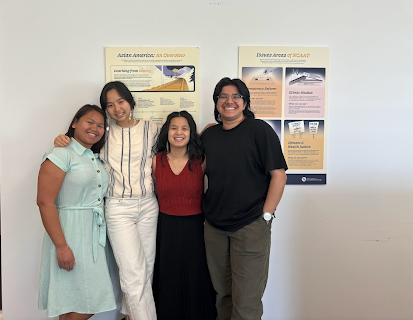
Language access research team from left to right: Staff members Sel Mpang and Phian Tran, Language Access Project Lead Ana Sucaldito, and staff member Sai Srivastava
Link to LEP-friendly version (English) here
Link to Karenni (ꤊꤢꤛꤢ꤭ ꤜꤟꤤ꤬) translation here
Link to Chinese (中文) translation here
Link to Khmer (ខ្មែរ) translation here
Link to Korean (한글) translation
Link to Vietnamese (Tiếng Việt) translation
Link to Hindi (हिन्दी) translation
Over the last year, NCAAT has partnered with Wake Forest School of Medicine to better understand the experiences of people who are Limited English Proficient (LEP) in North Carolina. We spoke with 29 community members, 62% who were LEP themselves, and 38% who were close friends or relatives of an LEP person.
We found that being LEP increases the difficulty of communicating, which can intensify stress in high-stakes situations (e.g. work conflicts, healthcare visits, finding housing) but can also impact day-to-day life (e.g. difficulty ordering food, disconnect from American pop culture). LEP status also limits access to needed resources impacting social determinants of health, such as healthcare, social services (e.g., Medicaid), and transportation. People who are LEP said that they felt that they were socially isolated, helpless, and relied on others too much for basic tasks.
This contributed to stress and anxiety for the LEP person which was often shared by people who supported them. Some LEP supporters spoke of a feeling of pride in being bilingual, and others discussed feeling burdened and undue guilt and pressure when they were unavailable or otherwise unable to interpret for their LEP community members. Many LEP supporters began acting as interpreters at a young age, which caused additional stress due to this additional responsibility and lack of knowledge combined with their involvement in high-stakes activities involving governmental documentation or finances of the household, which changed the dynamics between parents and their children.
LEP Asian Americans most often experience discrimination through microaggressions (e.g., belittling, assumed lack of intelligence/knowledge, etc.). However, more direct forms of discrimination were also reported (e.g., racial profiling and physical assault). Many LEP individuals discussed concerns about safety, such as feeling unprotected by the police. LEP folks are vulnerable to scams of many kinds (e.g. financial, misinformation) due to language barriers.
The top settings in need of interpretation and translation services were healthcare, legal settings, government and social service settings, and education. These settings are often high-stakes, and professionals in these settings utilize a lot of technical jargon and thus can be difficult to understand if one is LEP.
Participants shared that they often handled these barriers by bringing a friend or family member to interpret for them informally. This can make things easier as it allows for face-to-face interpretation (which was preferred to interpreters that were available remotely) and these interpreters speak the same dialect as the LEP person. However, these informal interpreters may not be accepted by the institution, especially in healthcare, and because they function as volunteers, scheduling presents a challenge. LEP people may also be uncomfortable with their friends/family finding out more personal information about them because they are interpreting.
Informal interpreters are most often found through personal connections, but we also heard from participants that they often relied on their religious communities (temples and churches) to seek assistance. Some participants shared that when they did not have an interpreter, they would use translation apps like Google Translate, ask for information to be written down, and work with an informal interpreter to prepare for and translate information ahead of time. Some LEP folks are more comfortable/proficient in written English than spoken; for these individuals, written materials (e.g., texts, emails, documents, summaries) may improve their ability to access and understand needed information. Written summaries were also sometimes brought back and translated at another time by an informal interpreter or translator. Translated materials were also sometimes used at the institution itself, but not every community has high enough rates of literacy for translation to be seen as a replacement for interpretation.
In addition to individual actions, communities utilized collective action to address language barriers. Some communities came together to organize ESL classes, advocate for language access at local institutions, and address harm caused by language barriers.
When asked about political and civic engagement information, the vast majority of interviewees shared that they have never been contacted in their native language about civic or social issues. The limited information that is received in-language is usually about voting rights and access and is received during election season. Information that is received in English is either considered 1) too complex or, on the opposite end, 2) very shallow/simple. After voting information, the next most common type of civic communication is information on racial justice, followed by labor rights. Information about environmental justice is the least common by far. LEP individuals were less likely to be proficient in politics and civic participation than their bilingual supporters.
Participants often find political information in their native language online through social media such as Facebook, YouTube, and WeChat. Other sources were ethnic-specific newspapers, and tv/news channels. These sources typically speak about national elections, and information and news about local elections are limited. Participants reported that language barriers limited the ability to access the breadth of information available or multiple points of view, making individuals vulnerable to misinformation and less able to participate in the civic process.
The interviewees recommended that language access and language justice could be improved by providing more interpretation and translation services by increasing government funding, thus offering interpreters more resources and better benefits for their work. They also shared that they strongly prefer working with in-person interpreters. Further, they ask that organizations and institutions make any existing interpretation services more clear, and train their staff on their availability, process, and best practices. They emphasized that solutions should be community-driven and initiated.
